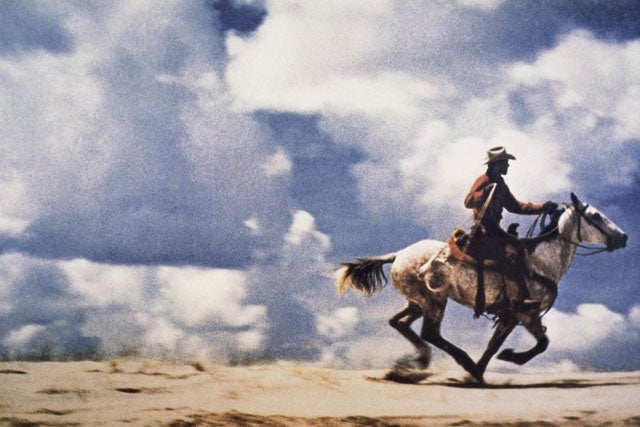Richard Prince: Continuation, Serpentine Gallery, London

When Richard Prince was growing up on the outskirts of Boston, the posters on his bedroom wall were not of The Beach Boys or his local baseball heroes but of Franz Kline and Jackson Pollock. The images did not show the artists actually painting. Prince was not particularly interested in their art. What attracted him were the artists themselves, with their machismo cool and insouciant self-confidence. He wanted to be like them. That is why he became an artist.
The press release for this new show Continuation, his first major British exhibition, suggests that Prince is "one of the world's most celebrated artists and one of its greatest innovators". It is a huge claim and not one that's always substantiated by this exhibition.
Watch: A preview and discussion of the show
Prince's subject is the American dream: cars, girls, motorbikes, cowboys and empty landscapes. His passion for cars means that right beside his painting and photography studios in upstate New York is a "body shop", where his collection of car bonnets are turned into art. Bonnets as both sculptures and painting abound here, painted in pale greys and greens. His pièce de résistance is a Buick called Covering Hannah (1987 Grand National). Here he's wrapped a car in a vinyl print of naked girls, turning a car into the ultimate object of male desire.
Born in 1949, Prince is a child of the Sixties. He took part in the 1968 anti-Vietnam marches in Washington, and resistance and rebellion have coloured his life. What he has succeeded in doing is making a virtue out of a lack of originality through the act of appropriation. Spoken of as being iconoclastic and redefining authorship, as well as raising questions about authenticity and the uniqueness of an art work, his appropriated images taken from magazines, popular culture and pulp fiction follow in the wake of Andy Warhol's Brillo boxes. Yet it is hard to tell whether they are, in fact, a critique of consumerist culture or simply a symptom of it.
It all began in the late Seventies when Prince started to re-photograph commercial photos, passing them off as "original" works. In 2005 he achieved a degree of notoriety when his image Untitled (Cowboy), lifted from the Marlboro Man commercials, became the first photograph to fetch more than $1m (£500,000) at auction. What Prince does is to unsettle our sense of reality, by selecting and representing what already exists. His cowboy image reminds us that the concept of the Wild West is simply a construct and a fiction, and that his appropriations are in themselves fictions, distorting mirrors reflecting the consumerist society from which they are culled back at itself.
The relationship between image and language, which has been a key investigation for many conceptual artists, is played out in his Monochrome Joke series, begun in 1987. These silk-screened popular jokes, produced as an ironic dig at the art market, have since been appropriated by that very market. For they have sold rather well, raising further tricky questions about authenticity and value.
His eye for women is largely pornographic. Semi-nude girl bikers in his Gang series pose provocatively on large machines, while his Nurse paintings are culled from the front covers of trashy paperbacks. One, entitled Washington Nurse, shows a well-endowed woman in a white uniform being embraced in front of the White House by someone who looks alarmingly like Ronald Reagan.
To 7 September (020-7402 6075). Media partner 'The Independent'
Subscribe to Independent Premium to bookmark this article
Want to bookmark your favourite articles and stories to read or reference later? Start your Independent Premium subscription today.

Join our commenting forum
Join thought-provoking conversations, follow other Independent readers and see their replies